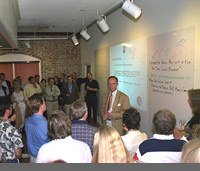 |
Working Group SessionSMART ITEMS BUSINESS FORUM (SIBF) WORKING
GROUP: OCTOBER 27, 2003 View Mike Bean's Presentations below: Mars,
Battlefield and BP (9.1MB .pdf) To view SUMMARY click Here (138kb .pdf) In the second session in a three-part series on commercial usage of sensor nets, this Smart Items Business Forum Working Group will focus on the viability of battery-based, low-powered radios in supporting communication for industrial control applications within the petroleum industry. The academic and industrial research area of Sensor Networks covers a wide range of technology issues. One outgrowth of this research is commercial short-range battery-powered radios that can provide low-bandwidth data streams across multiple nodes of an ad-hoc network. This technology approach has an obvious contribution when conventional communication structures are not possible, for example on battlefields and on the surface of Mars. Some proponents of this technology have argued that it can greatly reduce the cost of providing data connectivity in industrial control situations. If data connectivity is substantially cheaper, then it should open up more sensor and control applications that can lead to overall process savings, improved reliability, reduced emissions, and so forth. Around these new control and monitoring applications new business processes will be needed and new enterprise-scale applications. Petroleum processing and distribution is an example of a high value industry that has processing plants and pipelines spread over large geographical areas in very harsh environments. The cost of providing data connectivity is considered very high. This Working Group session will focus on the technology requirements for out-door control and monitoring capabilities in the oil industry. The Working Group will address three major areas: 1. What are the characteristics of modern, current data communication and industrial control technologies used in refineries and along pipelines?
2. If there were a dramatic cost reduction in providing safe, reliable data communication for petroleum industry environments, then how would it be deployed?
3. What developments of existing sensor net data communications technology would be needed for deployment in oil industry environments?
We expect to have several contributors from the petroleum industry - experts in industrial controls - share their knowledge of what is used today and what the industry needs. Working Group participants will discuss the viability of current technologies, as well as the benefits to the petroleum industry resulting from the deployment of radio-based sensor nets. Note: In order to keep the discussion focused on potential new applications and data sources, we will exclude certain relatively established applications and technologies. For example, applications of transponders and geographical location and tracking technology have been covered widely in the marketplace. REGISTRATION INFORMATION To register for this SIBF Working Group, please submit your name, title, telephone number, and a short bio to: Dr. Susan J. Duggan There is no fee to attend, however, as this in an invitation-only session limited to 18 participants, the commitment to participate is strongly requested.
|